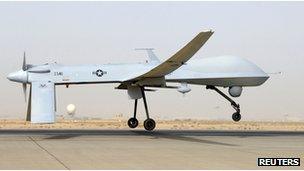Researchers use spoofing to 'hack' into a flying drone
- Published

Drones are mostly used for military operations
American researchers took control of a flying drone by "hacking" into its GPS system - acting on a $1,000 (¬£640) dare from the US Department of 91»»±¨land Security (DHS).
A University of Texas at Austin team used "spoofing" - a technique where the drone mistakes the signal from hackers for the one sent from GPS satellites.
The same method may have been used to bring down a US drone in Iran in 2011.
Analysts say that the demo shows the potential danger of using drones.
Drones are unmanned aircraft, often controlled from a hub located thousands of kilometres away.
They are mostly used by the military in conflict zones such as Afghanistan.
Todd Humphreys and his colleagues from <link> <caption>the Radionavigation Lab at the University of Texas at Austin</caption> <url href="http://radionavlab.ae.utexas.edu/" platform="highweb"/> </link> hacked the GPS system of a drone belonging to the university.
They demonstrated the technique to DHS officials, using a mini helicopter drone, flown over a stadium in Austin, said <link> <caption>Fox News, who broke the story</caption> <url href="http://www.foxnews.com/scitech/2012/06/25/drones-vulnerable-to-terrorist-hijacking-researchers-say/" platform="highweb"/> </link> .
"What if you could take down one of these drones delivering FedEx packages and use that as your missile?" Fox News quoted Mr Humphreys.
"That's the same mentality the 911 attackers had."
Potential dangers
The spoofed drone used an unencrypted GPS signal, which is normally used by civilian planes, says Noel Sharkey, co-founder of the International Committee for Robot Arms Control.
"It's easy to spoof an unencrypted drone. Anybody technically skilled could do this - it would cost them some ¬£700 for the equipment and that's it," he told 91»»±¨ News.
"It's very dangerous - if a drone is being directed somewhere using its GPS, [a spoofer] can make it think it's somewhere else and make it crash into a building, or crash somewhere else, or just steal it and fill it with explosives and direct somewhere.
"But the big worry is - it also means that it wouldn't be too hard for [a very skilled person] to work out how to un-encrypt military drones and spoof them, and that could be extremely dangerous because they could turn them on the wrong people.
- Published18 June 2012
- Published31 January 2012
- Published14 June 2012